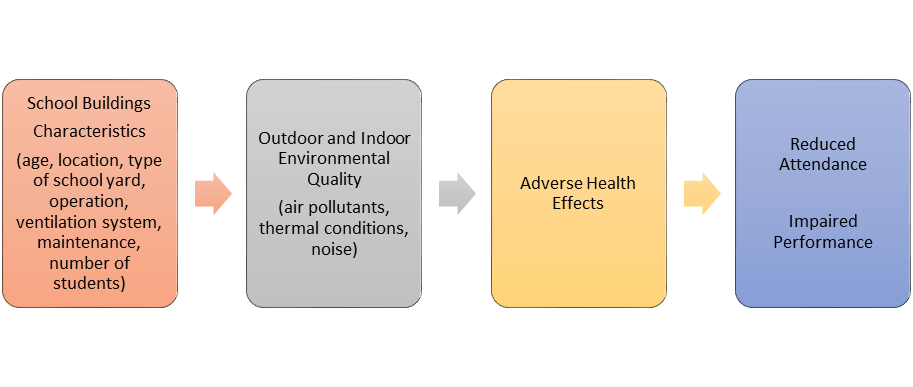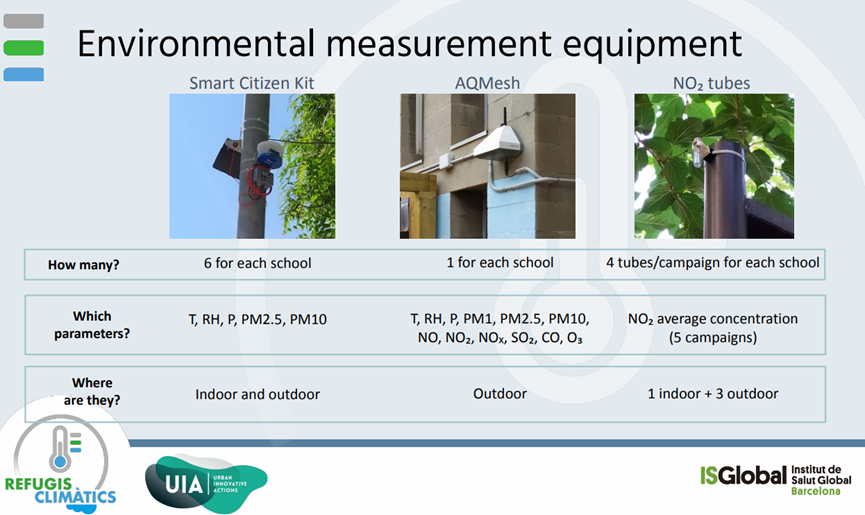
Creating Healthy Air Quality in Schools
Public concern has increased in recent years on outdoor and indoor environment in schools, with the attention focusing on air pollutants and thermal conditions, and on a range of adverse effects including recognized diseases, attitude patterns, and impaired performance.
The GBG_A2CC project of the City of Barcelona (also referred to as Climate Shelters) primarily aims at converting through blue, green and grey interventions, schools and their yards to cool islands (for more information see https://uia-initiative.eu/en/uia-cities/barcelona-call3), to support the adaptation plan of Barcelona to climate change as far as heat waves are concerned.
The project has not exhausted its actions in mitigating heat but has also addressed outdoor and indoor air quality at the school environment. As a result, a solid measurements’ plan was developed leading to the thorough understanding of the state of the school environment and acting as a blueprint to be replicated to other cities as well.
Air quality in schools
Outdoor and indoor environments in schools are of public concern taken that children have greater susceptibility to some environmental pollutants than adults, as they breathe higher volumes of air relative to their body weights and their organs are actively growing (https://ajuntament.barcelona.cat/qualitataire/en/la-salut/effects-health). In addition, adverse air quality conditions can affect the learning and overall performance of students in schools.
Regarding indoor pollutant levels, they can be several times higher compared to outdoor ones (as poor ventilation leads to higher concentrations). Furthermore, each school environment is uniquely characterized, and thus, each personal (student or teacher) exposure is determined by a combination of the outdoor and indoor pollutant levels as well as the mix of pollutants. In fact, age and location (for instance close to a highway or a busy street) of school buildings, the type of the school-yard (artificial surfaces or bare soil), the operation pattern and the ventilation system of the school and the number of students, all impact the state of the outdoor and indoor air quality, leading to adverse health effects (Figure 1).

Figure 1. Outdoor and Indoor Environmental Quality at schools: from school buildings’ characteristics to impacts.
In Barcelona, higher levels of air pollutants have been recorded in school playgrounds and classrooms when simultaneously compared with local urban background quality monitoring site. Outdoor PM2.5 levels at schools almost double the usual background levels reported for Barcelona, mainly because of the high PM2.5 contribution of local school sources of mineral dust and indoor organic compound (outdoor organic compound is mainly the sum of local traffic and city-scale traffic emissions). Indoor levels for NO2 are very close to those found outdoors, indicating a rather easy penetration of outdoor air pollutants into indoor environments (https://www.sciencedirect.com/science/article/pii/S0160412014001202).
The GBG_A2CC air quality measurements’ plan
The project has promoted the installation of environmental (for indoor and outdoor air quality) measuring equipment in each of the 11 schools participating in the project. The methodology that was applied, consisted of five steps: data collection, quantification of the available data, filtering and data cleaning, data validation and correction (for instance testing the equipment prior to its installation against a reference one) and data analysis. Prior to the analysis of the data, calibration/intercomparison among different types of equipment and control kits (deployed at distance from the intervention areas) was performed along with the correction of systematic biases.
Measurements have been made throughout the project (although with some gaps due to the closure of schools during the pandemic or technical difficulties), thus creating an invaluable data base for assessing indoor and outdoor air quality at the participating schools. Considering that the measurements were also taken prior and after the interventions in each school, their impact was examined in terms of changes in indoor and outdoor air quality. Figure 2 shows the type of environmental measurement equipment that was installed at schools for both indoor and outdoor measurements of several pollutants (Source: ISGlobal).

Figure 2. Description of the environmental measurement equipment used within the GBG_A2CC project (T: air temperature, RH: relative humidity; P: pressure; PM: Particulate Matter of various diameters from 1 μm to 10 μm; NO: nitrous oxide; NO2; nitrogen dioxide; SO2: sulphur dioxide; CO: carbon monoxide; O3: ozone).
Exploiting the measurements
Special attention is given to PMs and NO2. PMs are important indicators of both outdoor and indoor air quality as their presence can be related to a multitude of distinct as well as interrelated reasons. For instance, high concentrations of PMs outdoors may be the result of the location of a school, namely close to an industrial area or at a street with high volume of traffic. Furthermore, the presence of PM indoors can be related to insufficient ventilation in schools (especially in winter), infrequently cleaned indoor surfaces, high number of students compared to the room area and volume and physical activity of the students leading to the resuspension of particles from room surfaces. The size of these particles is directly linked to their potential for causing health problems. Fine particles, PM1 and PM2.5, pose the greatest health risk as they can get deep into lungs, and some may even get into the bloodstream. Exposure to these particles can affect a person's lungs and heart and are also associated with bronchitis and asthma attacks. NO2 is a gaseous pollutant generated from fossil fuel combustion, while in recent years it has emerged as one of the most notable pollutants associated with health effects. In urban environments, NO2 is primarily generated by traffic-related combustion and buildings’ heating with fossil fuels (gas, oil, and coal). (https://www.who.int/news-room/fact-sheets/detail/ambient-(outdoor)-air-quality-and-health).
Figure 3 (a,b) presents the PM 2.5 daily concentrations in one of the participating schools (Els Llorers) against the daily and annual levels of WHO. A gradual reduction in the daily concentrations of PM2.5 is observed especially after the summer of 2020, namely upon the completion of the interventions at the schools.


Figure 3. Particulate Matter (PM2.5) daily concentrations for Els Llorers school (source: ISGlobal).
Similarly, Figure 4 presents the NO2 average concentrations (in μg/m3) both indoor (classroom) and outdoor, while the dashed line refers to the NO2 limit. Measurements refer to all 11 schools participating in the project and extend from August 2019 to July 2021, while the varying levels depend among others on the location of each school and the school buildings characteristics. In all graphs, a declining trend is overall observed for both indoor and outdoor NO2 concentrations. Although the declining trend is mostly associated to the COVID-19 pandemic mobility restrictions, the interventions applied to schools are expected to also contribute to improved air quality.

Figure 4. Outdoor and indoor nitrogen dioxide concentrations at the participating schools of the GBG_A2CC project (source: ISGlobal).
The way forward
Taken that reducing traffic emissions and replacing fossil fuels with clean ones are challenging, there are easier means to reduce outdoor and indoor PM and NO2 concentrations, including location planning of new schools and classrooms, increasing greenery in school yards, applying energy efficiency measures, reducing the use of PMs or NO2-releasing indoor sources, limiting the number of students in classrooms, more frequently cleaning of indoor surfaces, etc. Moreover, improving ventilation (windows and filters) can significantly reduce the concentrations of indoor air pollutants. As a matter of fact, modern ventilation systems are self-regulating and increase or decrease ventilation as needed. They can be also combined with smart detection devices installed in each classroom that announce when it is time to increase ventilation, take a break, or simply open the window and ventilate.
What is also important to note is that the measures to turn our cities to climate resilient ones, can be effectively linked with plans to improve indoor and outdoor air quality. The GBG_A2CC project of the City of Barcelona demonstrates that this dual challenge is feasible, also for the school environment where students and teachers spend several hours daily.
About this resource
The Urban Innovative Actions (UIA) is a European Union initiative that provided funding to urban areas across Europe to test new and unproven solutions to urban challenges. The initiative had a total ERDF budget of €372 million for 2014-2020.
Similar content




